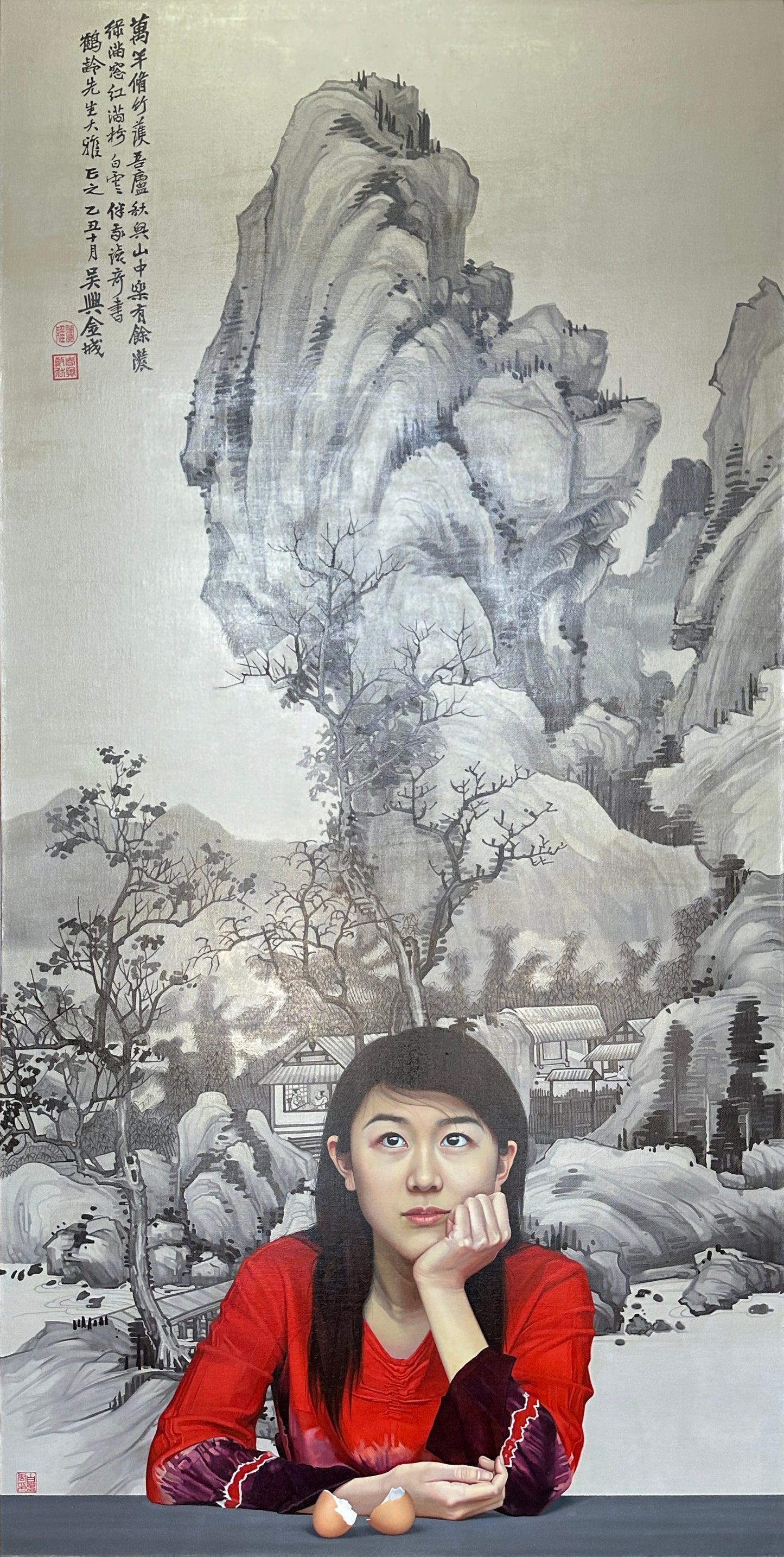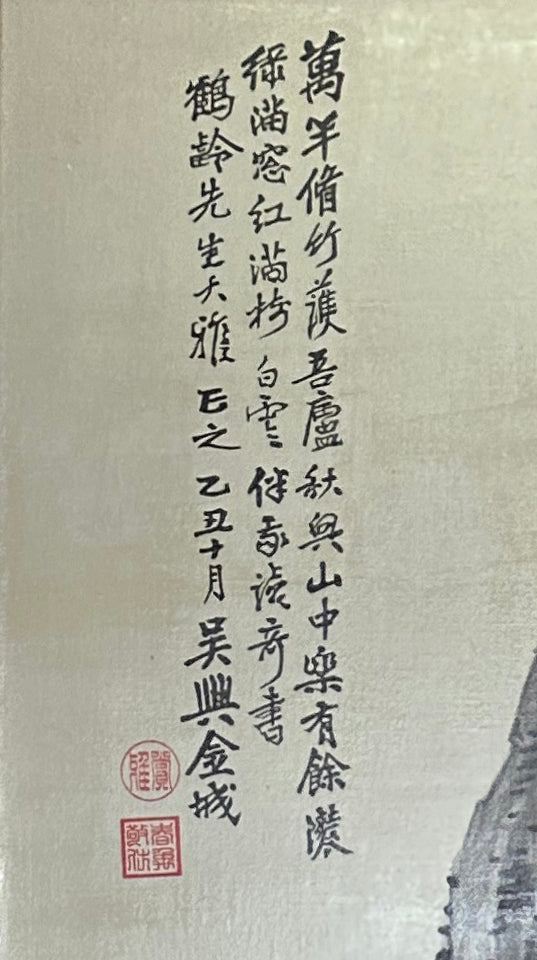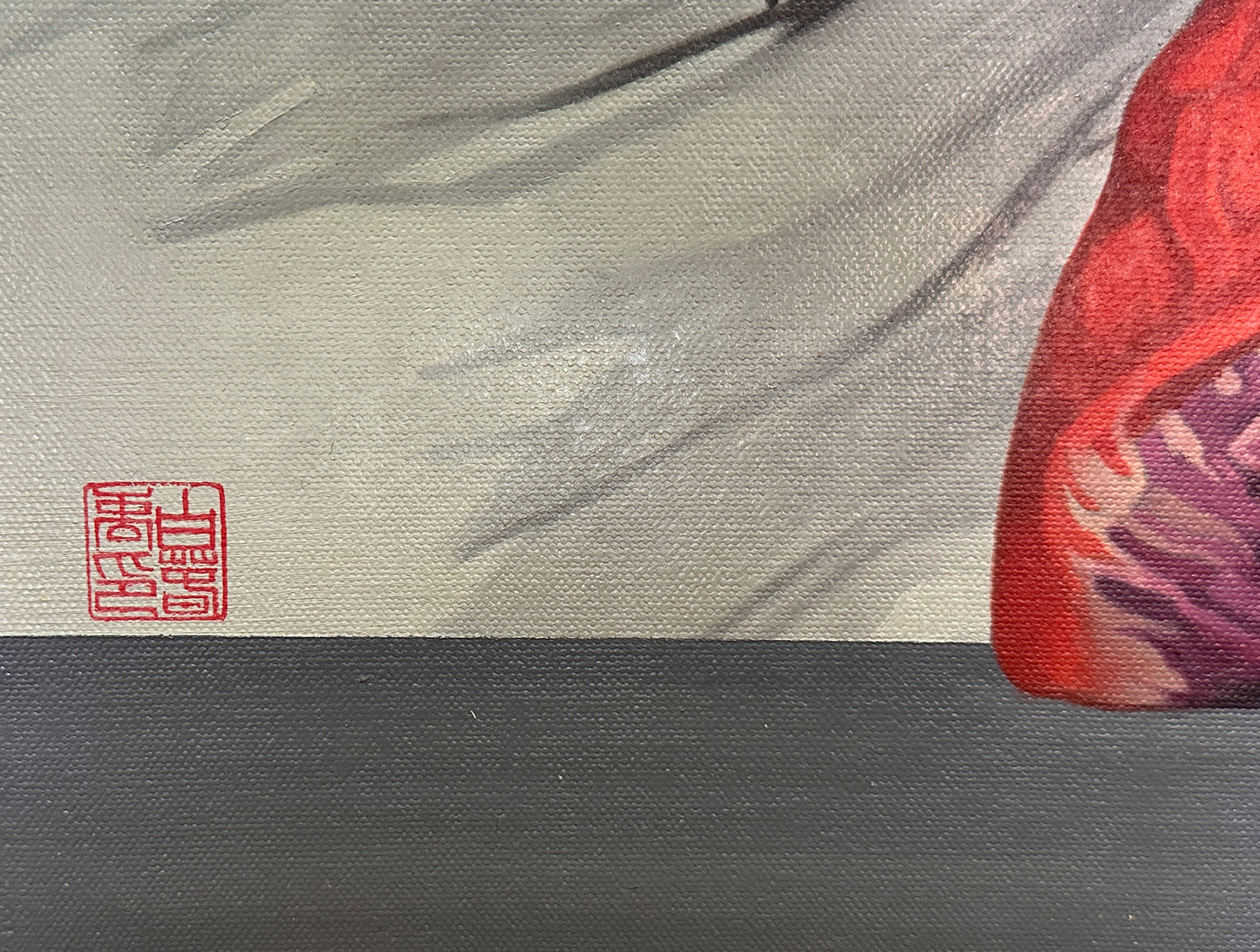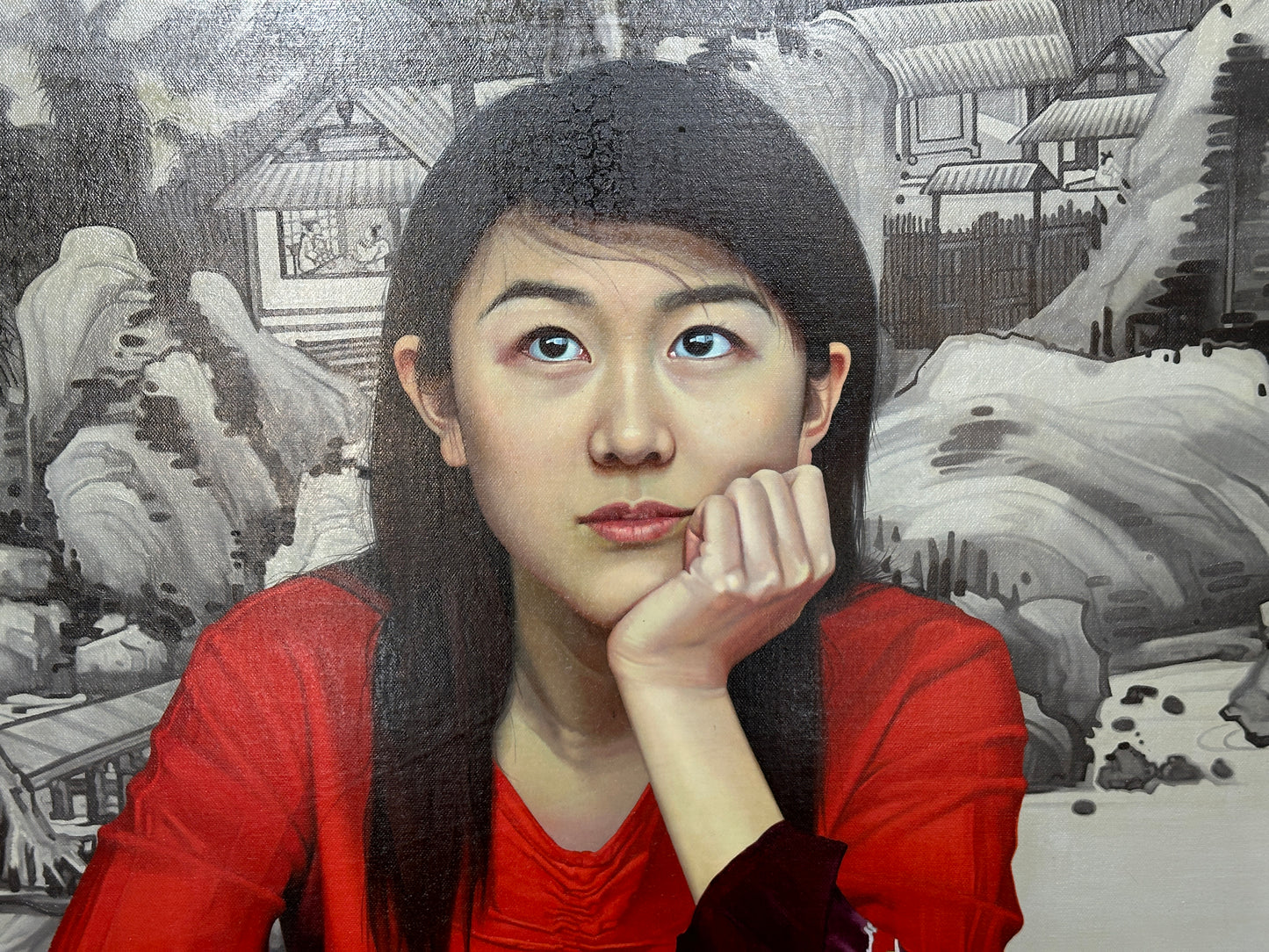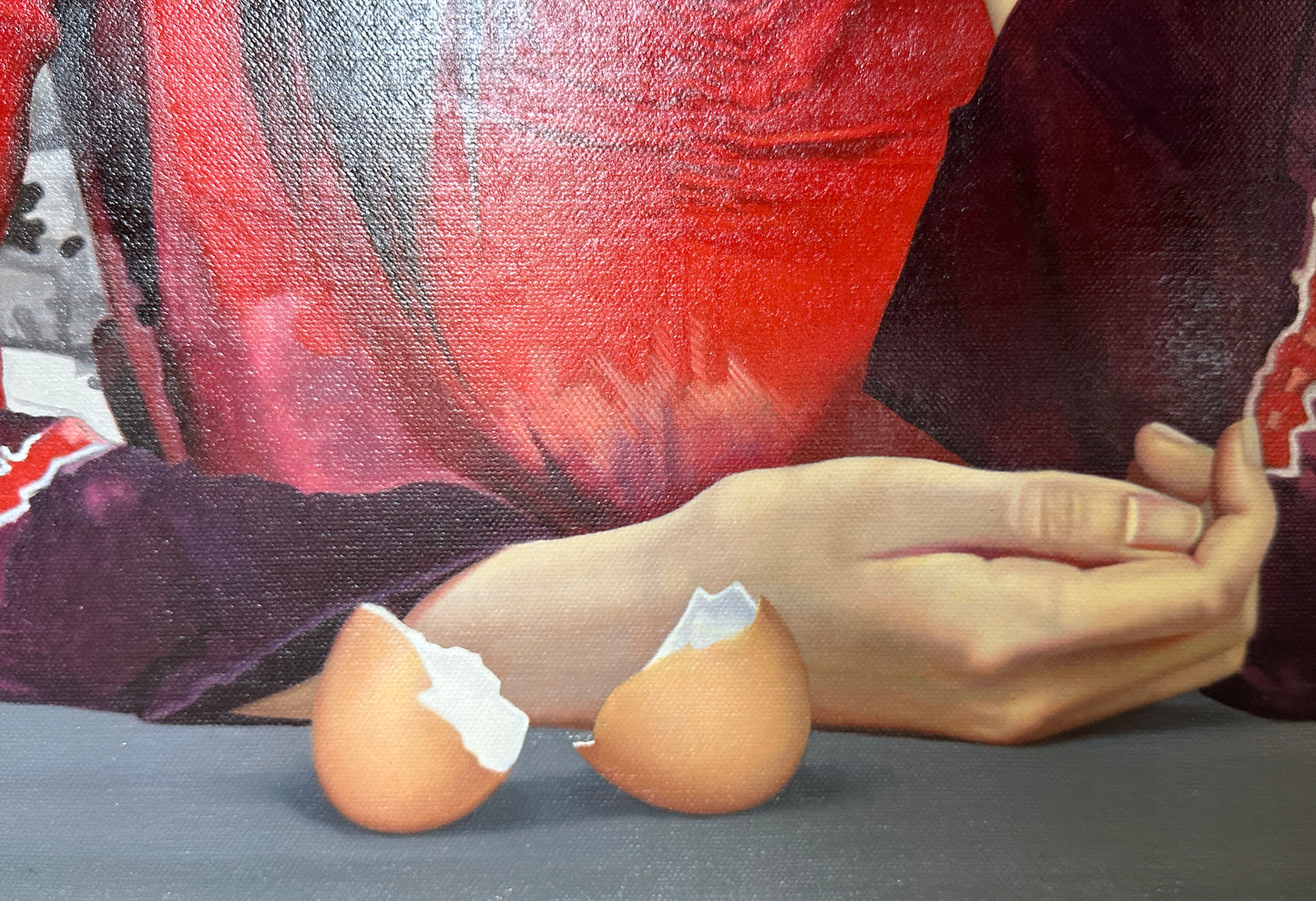bqt.art
Landscape, 2008
Landscape, 2008
Couldn't load pickup availability
Share
Artist: Bai Chunyu 白春禹
Title: Landscape | 山水
Materials: Oil on canvas
Size: 180 x 90 cm | 71 x 35 in (Mounted Frameless)
Rarity: Unique
Medium: Painting
Signature: Hand-signed by artist
Condition: Good
Frame: No
This visually captivating oil on canvas painting, titled Landscape by Bai Chunyu, combines elements of traditional Chinese landscape art with modern techniques, creating a poetic and evocative piece that bridges the gap between cultural heritage and contemporary artistic expression. Below is an in-depth analysis of its artistic elements, symbolism, and emotional resonance.
---
Subject and Composition
At first glance, the painting appears as a blend of two distinct thematic layers: a classical, monochromatic Chinese landscape in the background and a contemporary figure in the foreground. The towering mountains, intricately detailed trees, and atmospheric traditional scenery dominate the upper and middle portions of the canvas, while the lower portion focuses on a modern figure—a young woman seated at a table.
The mountains, rendered in a traditional Chinese ink wash style, rise dramatically from the base of the composition, creating a sense of grandeur and timelessness. The trees, small architectural details, and calligraphic inscriptions evoke the aesthetic and philosophical principles of Chinese landscape painting, which often emphasize harmony between humanity and nature.
The foreground introduces a stark contrast, as the realistic depiction of the young woman grounds the painting in the present. Her crimson red attire immediately draws the viewer's eye and establishes her as the focal point. Her contemplative pose—resting her chin on her hand and gazing upward—creates a narrative link between the two layers of the painting, as though her thoughts are extending into the landscape above.
---
Color Palette and Contrast
The painting employs a dualistic color scheme that underscores its thematic contrasts. The traditional landscape background is monochromatic, rendered in shades of gray and black that mimic the delicate, tonal gradations of Chinese ink wash painting. This subdued palette conveys a sense of serenity and timelessness, allowing the viewer to focus on the intricate details of the mountains, trees, and structures.
In contrast, the foreground figure is painted in vibrant, lifelike colors, with the woman’s red shirt serving as the most striking element. The red symbolizes vitality, passion, and cultural significance, while contrasting sharply with the muted tones of the background. This juxtaposition creates a visual and conceptual tension, emphasizing the interplay between modernity and tradition.
---
Details and Brushwork
The painting demonstrates exceptional attention to detail and technical skill in rendering its two distinct layers. The mountains, trees, and pavilions in the landscape are meticulously painted with fine, delicate brushstrokes, adhering to the stylistic conventions of classical Chinese landscape art. The soft, misty transitions and layered textures create depth and atmosphere, inviting the viewer to immerse themselves in the natural world depicted.
The foreground figure, meanwhile, is rendered with a high degree of realism. The smooth brushwork used to depict the girl’s skin contrasts with the dynamic, more expressive strokes seen in the background. Her red shirt, with its intricate folds and subtle patterns, adds a sense of texture and tactile presence to the painting.
The table in front of her is painted with a minimalist approach, allowing the small details on its surface—such as the two eggs, one broken—to stand out. These objects are painted with remarkable precision, their simplicity inviting symbolic interpretation.
---
Symbolism and Interpretation
The painting is rich with symbolism, blending cultural and philosophical ideas:
1. The Landscape as a Representation of Thought or Memory
The towering mountains and vast natural scenery can be interpreted as a representation of the girl’s inner world—her thoughts, dreams, or memories. In Chinese art, mountains often symbolize strength, permanence, and a connection to the divine, while the misty atmosphere suggests mystery and introspection. By situating the landscape "above" the girl, the painting may be suggesting that her thoughts are deeply rooted in cultural or ancestral history.
2. The Red Shirt and the Individual
The vibrant red of the girl’s shirt anchors her firmly in the present and highlights her individuality. In Chinese culture, red is a color of celebration, prosperity, and life force, making it a powerful symbol of vitality. Her modern appearance contrasts with the timeless quality of the landscape, emphasizing the coexistence of tradition and modernity.
3. The Eggs
The eggs on the table, one whole and one broken, symbolize duality—potential versus realization, fragility versus strength, or creation versus transformation. The broken egg, in particular, could represent an act of change or the passage of time, aligning with the painting’s broader themes of continuity and transition.
4. Calligraphy as a Cultural Anchor
The calligraphic inscriptions in the upper-left corner further ground the painting in traditional Chinese art forms. The text may contain a poem or commentary, reinforcing the landscape’s cultural and philosophical significance. The inclusion of the red artist seals enhances the sense of authenticity and cultural depth.
---
Emotional and Philosophical Undertones
The painting evokes a sense of introspection and contemplation, encouraging viewers to reflect on their own relationship with nature, culture, and identity. The girl’s upward gaze suggests curiosity, wonder, or a longing to connect with something greater than herself, while the serene, meditative quality of the landscape offers a space for reflection and self-discovery.
The contrast between the modern figure and the traditional landscape creates a dialogue about the passage of time and the interplay between past and present. It invites the viewer to consider how heritage and history shape contemporary life and how individuals navigate the balance between preserving tradition and forging new paths.
---
Style and Technique
The artist’s blending of two distinct artistic traditions—realistic portraiture and classical Chinese landscape painting—demonstrates mastery of both styles and a creative vision that bridges cultural and temporal divides. The use of light and shadow is particularly effective in the foreground, where soft highlights and subtle tonal shifts bring the girl to life. In the background, the ink wash technique creates a sense of depth and atmosphere, with layers of mountains receding into the distance.
---
Overall Impact
“Landscape” is a visually and conceptually rich painting that explores the intersection of tradition and modernity, individuality and cultural heritage. Through its harmonious composition, contrasting color palette, and symbolic elements, the painting invites viewers to reflect on their own connections to history, nature, and the broader human experience.
The work’s ability to seamlessly integrate classical Chinese aesthetics with contemporary realism makes it both timeless and relevant, offering a poignant meditation on identity, memory, and the enduring beauty of the natural world. It is a testament to the power of art to transcend boundaries and create meaningful connections across time and culture.
